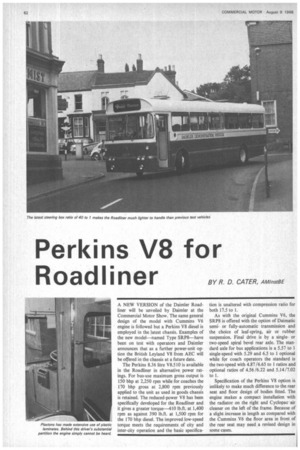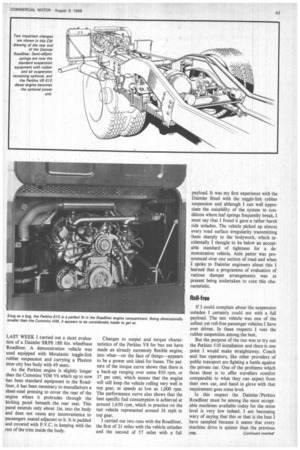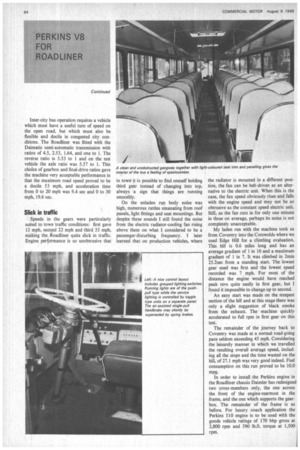Perkins V8 for
Page 64

Page 65

Page 66

If you've noticed an error in this article please click here to report it so we can fix it.
Roadliner BY R. D. CATER, AMInstBE
A NEW VERSION of the Daimler Roadliner will be unveiled by Daimler at the Commercial Motor Show. The same general design of the model with Cummins V6 engine is followed but a Perkins V8 diesel is employed in the latest chassis. Examples of the new model—named Type SRP8—have been on test with operators and Daimler announces that as a further power-unit option the British Leyland V8 from AEC will be offered in the chassis at a future date.
The Perkins 8.36 litre V8.510 is available in the Roadliner in alternative power ratings. For bus-use maximum gross output is 150 bhp at 2,250 rpm while for coaches the 170 bhp gross at 2,800 rpm previously applied to the unit as used in goods chassis is retained. The reduced-power V8 has been specifically developed for the Roadliner and it gives a greater torque-410 lb.ft. at 1,400 rpm as against 390 lb.ft. at 1,500 rpm for the 170 bhp diesel. The improved low-speed torque meets the requirements of city and inter-city operation and the basic specifica
tion is unaltered with compression ratio for both 17.5 to 1.
As with the original Cummins V6, the SRP8 is offered with the option of Daimatic semior fully-automatic transmission and the choice of leaf-spring, air or rubber suspension. Final drive is by a singleor two-speed spiral bevel rear axle. The standard axle for bus applications is a 5.57 to 1 single-speed with 5.29 and 6.5 to 1 optional while for coach operators the standard is the two-speed with 4.87/6.65 to 1 ratios and optional ratios of 4.56 /6.22 and 5.14/7.02 to I.
Specification of the Perkins V8 option is unlikely to make much difference to the rear seat and floor design of bodies fitted. The engine makes a compact installation with the radiator on the right and Cyclopac air cleaner on the left of the frame. Because of a slight increase in length as compared with the Cummins V6 the floor area in front of the rear seat may need a revised design in some cases.
LAST WEEK I carried out a short evaluation of a Daimler SRP8 18ft 6in. wheelbase Roadliner. A demonstration vehicle was used equipped with Metalastic toggle-link rubber suspension and carrying a Plaxton inter-city bus body with 49 seats.
As the Perkins engine is slightly longer than the Cummins VIM V6 which up to now has been standard equipment in the Roadliner, it has been necessary to manufacture a sheet-steel pressing to cover the rear of the engine where it protrudes through the kicking panel beneath the rear seat. This panel extends only about lin. into the body and does not cause any inconvenience to passengers seated adjacent to it. It is padded and covered with P.V.C. in keeping with the rest of the trim inside the body. Changes to output and torque characteristics of the Perkins V8 for bus use have made an already extremely flexible engine, into what—on the face of things—appears to be a power unit ideal for buses. The pattern of the torque curve shows that there is a back-up ranging over some 850 rpm, or 37 per cent, which means that the engine will still keep the vehicle rolling very well in top gear, at speeds as low as 1,000 rpm. The performance curve also shows that the best specific fuel consumption is achieved at around 1,650 rpm, which in practice on the test vehicle represented around 36 mph in top gear.
I carried out two runs with the Roadliner, the first of 21 miles with the vehicle unladen and the second of 57 miles with a full payload. It was my first experience with the Daimler fitted with the toggle-link rubber suspension and although I can well appreciate the suitability of the system to conditions where leaf springs frequently break, I must say that I found it gave a rather harsh ride unladen. The vehicle picked up almost every road surface irregularity transmitting them sharply to the bodywork, which incidentally I thought to be below an acceptable standard of tightness for a demonstration vehicle. Axle patter was pronounced over one section of road and when I spoke to Daimler engineers about this I learned that a programme of evaluation of various damper arrangements was at present being undertaken to cure this characteristic.
Roll-free
If I could complain about the suspension unladen I certainly could not with a full payload. The test vehicle was one of the softest yet roll-free passenger vehicles I have ever driven. In these respects I vote the rubber suspension among the best.
But the purpose of the run was to try out the Perkins 510 installation and there is one point I would make straightaway. Coach and bus operators, like other providers of public transport are fighting a battle against the private car. One of the problems which faces them is to offer travellers comfort comparable to what they can expect from their own car, and hand in glove with that requirement goes noise level.
In this respect the Daimler /Perkins Roadliner must be among the most acceptable machines available today for the noise level is very low indeed. I am becoming wary of saying that this or that is the best I have sampled because it seems that every machine drive is quieter than the previous Inter-city bus operation requires a vehicle which must have a useful turn of speed on the open road, but which must also be flexible and docile in congested city conditions. The Roadliner was fitted with the Daimatic semi-automatic transmission with ratios of 4.5, 2.53, 1.64, and one to I. The reverse ratio is 5.53 to 1 and on the test vehicle the axle ratio was 5.57 to 1. This choice of gearbox and final-drive ratios gave the machine very acceptable performance in that the maximum road speed proved to be a docile 53 mph, and acceleration time from 0 to 20 mph was 9.4 sec and 0 to 30 mph, 19.6 sec.
Slick in traffic
Speeds in the gears were particularly suited to town traffic conditions: first gave 12 mph, second 22 mph and third 33 mph, making the Roadliner quite slick in traffic. Engine performance is so unobtrusive that in town it is possible to find oneself holding third gear instead of changing into top, always •a sign that things are running smoothly.
On the unladen run body noise was high, numerous rattles emanating from roof panels, light fittings and seat mountings. But despite these sounds I still found the noise from the electric radiator-cooling fan rising above them on what 1 considered to be a passenger-disturbing frequency. I later learned that on production vehicles, where the radiator is mounted in a different position, the fan can be belt-driven as an alternative to the electric unit. When this is the case, the fan speed obviously rises and falls with the engine speed and may not be so obtrusive as the constant speed electric unit. Still, as the fan cuts in for only one minute in three on average, perhaps its noise is not completely unacceptable.
My laden run with the machine took us from Coventry into the Cotswolds where we used Edge Hill for a climbing evaluation. This hill is 0.6 miles long and has an average gradient of 1 in 10 and a maximum gradient of 1 in 7. It was climbed in 2min 25.2sec from a standing start. The lowest gear used was first and the lowest speed recorded was 7 mph. For most of the distance the engine would have reached peak revs quite easily in first gear, but I found it impossible to change up to second.
An easy start was made on the steepest section of the hill and at this stage there was only a slight suggestion of black smoke from the exhaust. The machine quickly accelerated to full rpm in first gear on this test.
The remainder of the journey back to Coventry was made at a normal road-going pace seldom exceeding 45 mph. Considering the leisurely manner in which we travelled the resulting overall average speed, including all the stops and the time wasted on the hill, of 27.1 mph was very good indeed. Fuel consumption on this run proved to be 10.0 mpg.
In order to install the Perkins engine in the Roadliner chassis Daimler has redesigned two cross-members only, the one across the front of the engine-rearmost in the frame, and the one which supports the gearbox. The remainder of the frame is as before. For luxury coach application the Perkins 510 engine is to be used with the goods vehicle ratings of 170 bhp gross at 2,800 rpm and 390 !bit. torque at 1,500 rpm.
















































































































































